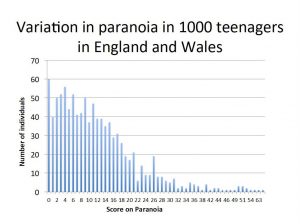In today’s blog post, Professor Angelica Ronald [guess contributor to our blog] outlines the genetic and environmental causes of paranoid thoughts.

Professor Angelica Ronald, director of the Genes Environment Lifespan laboratory at Birkbeck, University of London
Ever walked into a room just as someone burst into laughter and worried that they were laughing AT YOU? If the answer is yes, welcome to the (large) club of people having paranoid thoughts (albeit this might be considered a mild example of paranoia). More severe forms of paranoid thinking typically include believing there are coded messages about you in the press or TV, and that people are conspiring against you.
Paranoia relates to unfounded suspicions or mistrust that other people mean you harm. Paranoia is a key symptom of some forms of severe psychiatric illness that affect about 1 in 100 people. More recently we are realising that some paranoid thoughts can be common and are not restricted to people with a psychiatric illness. The latest research suggests these types of thoughts are just as common as depressive thoughts.
“some paranoid thoughts can be common and are not restricted to people with a psychiatric illness”
In my lab we are trying to understand what causes paranoia in teenagers. The hope is that perhaps we could reduce paranoid thoughts in this age group, before they become entrenched and severe. Paranoia at the extreme can be horrible to live with. It forms a key symptom within schizophrenia, which is an often debilitating psychiatric disorder. Paranoia often crops up with other problems too, like major depression.
Many of us have paranoid thoughts, varying in type and frequency. The bar chart shows the wide range of scores that teenagers have on a scale of paranoia. A higher score on the horizontal axis represents more paranoia. The vertical axis shows the number of teenagers who had each numerical score. The graph demonstrates the wide differences we see between teenagers in how paranoid they are in mid-adolescence. We might think that we can divide people up into paranoid and not paranoid. In reality, science does not support this view. Instead most people show some a degree of paranoia and there is lots of variation between individuals. To add to the complexity, paranoia comes and goes across time in each individual.
What causes paranoia? Genetic influences we have inherited from our parents play a key part in giving us a predisposition to being paranoid. We do not yet know the exact genes that are involved. Evidence so far suggests that there are a large number of genes each having a very small effect on the likelihood we will suffer from paranoia. This is called a “polygenic model”. We think genetic influences may explain about 50% of the type of variation shown in the figure.
Environment is equally as important as genetics in explaining teenage paranoia. Cannabis and tobacco use in teenagers are both associated with paranoia. Things like stressful life events as well as bullying show significant associations with paranoia. We also know that paranoia can exacerbate depressive feelings, and vice versa, leading to a vicious cycle of these different negative thoughts.
Research can help to understand the causes of paranoia, which may aid the development of potential treatments. Through understanding paranoia and discussing it publicly we aim to de-stigmatise and reduce it, one unhealthy thought at a time.
Professor Ronald can be heard discussing her research on delusions on BBC Radio 4 in the final episode on December 14th of the A History of Delusions radio series
Would you like to find out more about paranoia? The Mind charity offer some useful advice if you are suffering from paranoia and would like to seek help – see here.

